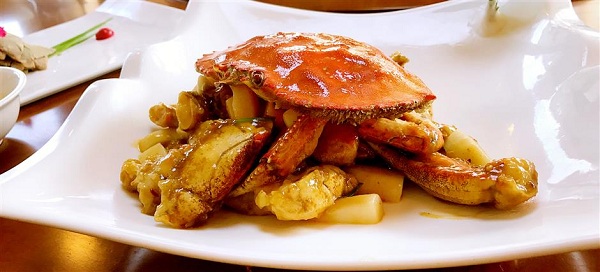
Gazami crab and rice cake stir-fry. (Ti Gong)
In the Qing Dynasty (1644-1911), Suzhou families would start to prepare rice cakes after the Laba Festival, which falls on the eighth day of the 12th lunar month. Rich families hired rice cake makers to make their own batches at home.
The long, thin rice cake was often offered to the servants as gifts, while the ones with the shoe-shaped gold ingot form were gifted to friends and family.
On the second day of the second lunar month, families in the countryside would fry and eat the leftover rice cakes from the previous year known as chengyaogao, or back support cakes, because eating that certain dish on that day was said to treat backache.
Just like other foods, rice cakes are made and cooked in different ways across China.
The Shanghainese rice cake often adds lard and sweet osmanthus flowers to create a smooth, sweet and sumptuous flavor.
The famous Chongming cake is also a food for the Spring Festival, made by grinding rice and glutinous rice to form a dough, then adding a generous amount of toppings including jujubes, raisins and walnuts before steaming.
Ningbo in Zhejiang Province is famous for rice cakes and related dishes which are also traditional Spring Festival foods. Here, the rice cakes are made of wanjingmi, or late grain rice, which is sowed after harvesting the early season rice in late June and reaped in November.
In order to achieve a sticky texture similar to glutinous rice, the rice must go through several essential procedures. After soaking in water for seven to 10 days and before it's put into the steamer, it must be milled first, hence the name shuimo niangao, or water mill rice cake.
The fine and smooth milled rice flour is then steamed fully on a high heat. The hot mixture is then smashed in a stone mortar, a key step that makes the rice sticky. The task must be completed by two people. One smashes hard with a wooden pestle, the other stirs the hot rice flour with cold water.
The rice cakes are often savory and cooked in stir-fries or soups in Ningbo. Signature recipes include rice cake and shepherd's purse stir-fry, gazami crab and rice cake stir-fry and rice cake soup with green vegetables and shredded pork. There's also the sweet rice cake with osmanthus sugar sauce.
In Cicheng, an ancient town in Ningbo known for rice cakes, there is a museum dedicated to the staple where visitors can learn all aspects of rice cake making, cooking and history.
Beijing-style rice cakes, which inherited the imperial court traditions, are an eyeful with different shapes and ingredients. They are often displayed as articles of tribute.
The rice cakes can be topped with crushed nuts, preserved fruits as well as honglusi, or red and green shreds, a candied and colored filling made of the peel of tangerine or radish. They also have sweet fillings inside, like red bean paste, jujube paste and hawthorn.
The rectangular rice cake from Xinyang, Henan Province, is as hard as a brick. The size of a palm, it's usually sliced into strips, fried and served with granulated sugar.
The Chaoxian ethnic group has a tradition of making rice cakes in fall and winter, which are known as dagao, or beaten cakes. The staple is a festival celebration food for Spring Festival and also a tribute to the gods when the people host worship ceremonies in the third lunar month.
Making dagao is really hard work. One must hammer the cooked glutinous rice in a wooden basin until a mushy texture is achieved, then move the mixture to a stone board and smash with a hammer even more into a pancake, while others help to arrange the shape of the rice cakes. Dagao is ready to eat after sprinkling on some soybean flour, sugar or honey.


















































